Market Cultural Report: Examining China's Cultural Impact on Business
VerifiedAdded on 2021/10/12
|11
|3414
|82
Report
AI Summary
This report provides a comprehensive market cultural analysis of China, examining various aspects relevant to businesses. It begins with a rationale for selecting China, highlighting its economic growth and workforce. The report then delves into a detailed cultural analysis of China, covering communication styles, language, etiquette, religion, education, and the role of science and technology. It proceeds to compare China's business culture with that of Singapore, exploring differences in business mentality, conversation styles, body language, and meeting protocols. The report also incorporates Hofstede's cultural dimensions to further understand Chinese society, specifically focusing on power distance, individualism versus collectivism, and masculinity versus femininity. The analysis aims to provide insights into how cultural factors influence business operations in China, making it a valuable resource for those looking to understand and engage with the Chinese market. The report is designed to assist students in understanding the impact of culture on international business.
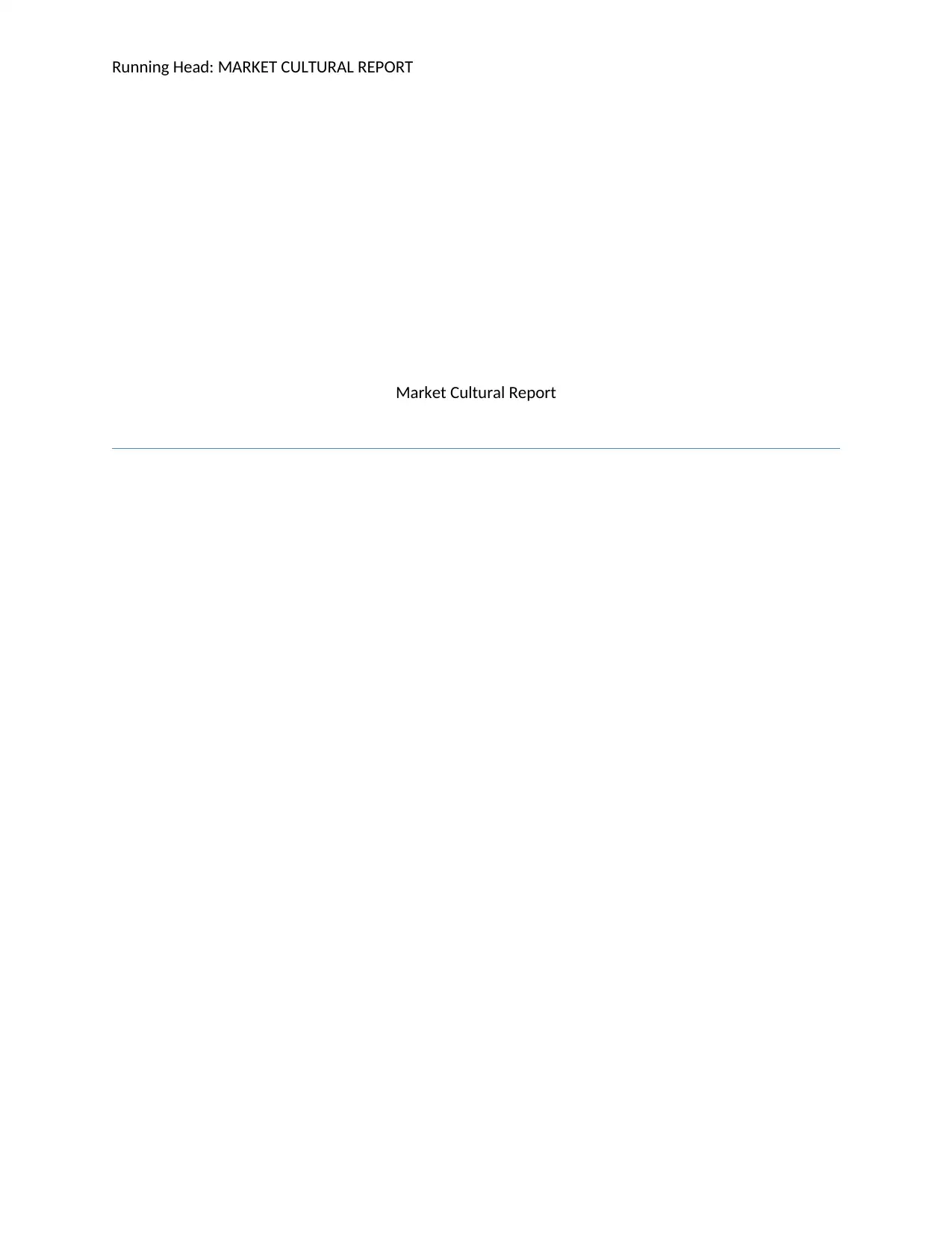
Running Head: MARKET CULTURAL REPORT
Market Cultural Report
Market Cultural Report
Paraphrase This Document
Need a fresh take? Get an instant paraphrase of this document with our AI Paraphraser
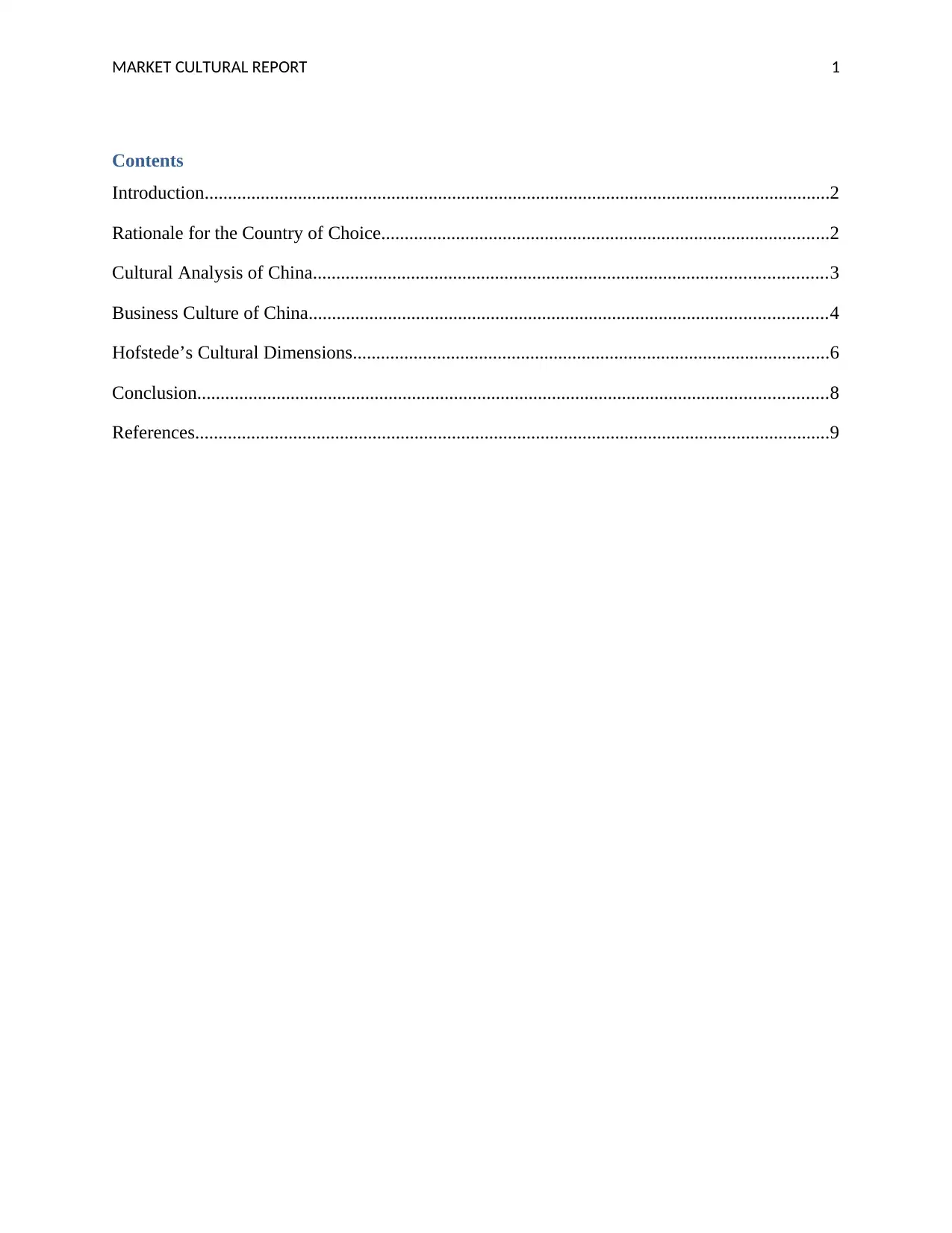
MARKET CULTURAL REPORT 1
Contents
Introduction......................................................................................................................................2
Rationale for the Country of Choice................................................................................................2
Cultural Analysis of China..............................................................................................................3
Business Culture of China...............................................................................................................4
Hofstede’s Cultural Dimensions......................................................................................................6
Conclusion.......................................................................................................................................8
References........................................................................................................................................9
Contents
Introduction......................................................................................................................................2
Rationale for the Country of Choice................................................................................................2
Cultural Analysis of China..............................................................................................................3
Business Culture of China...............................................................................................................4
Hofstede’s Cultural Dimensions......................................................................................................6
Conclusion.......................................................................................................................................8
References........................................................................................................................................9
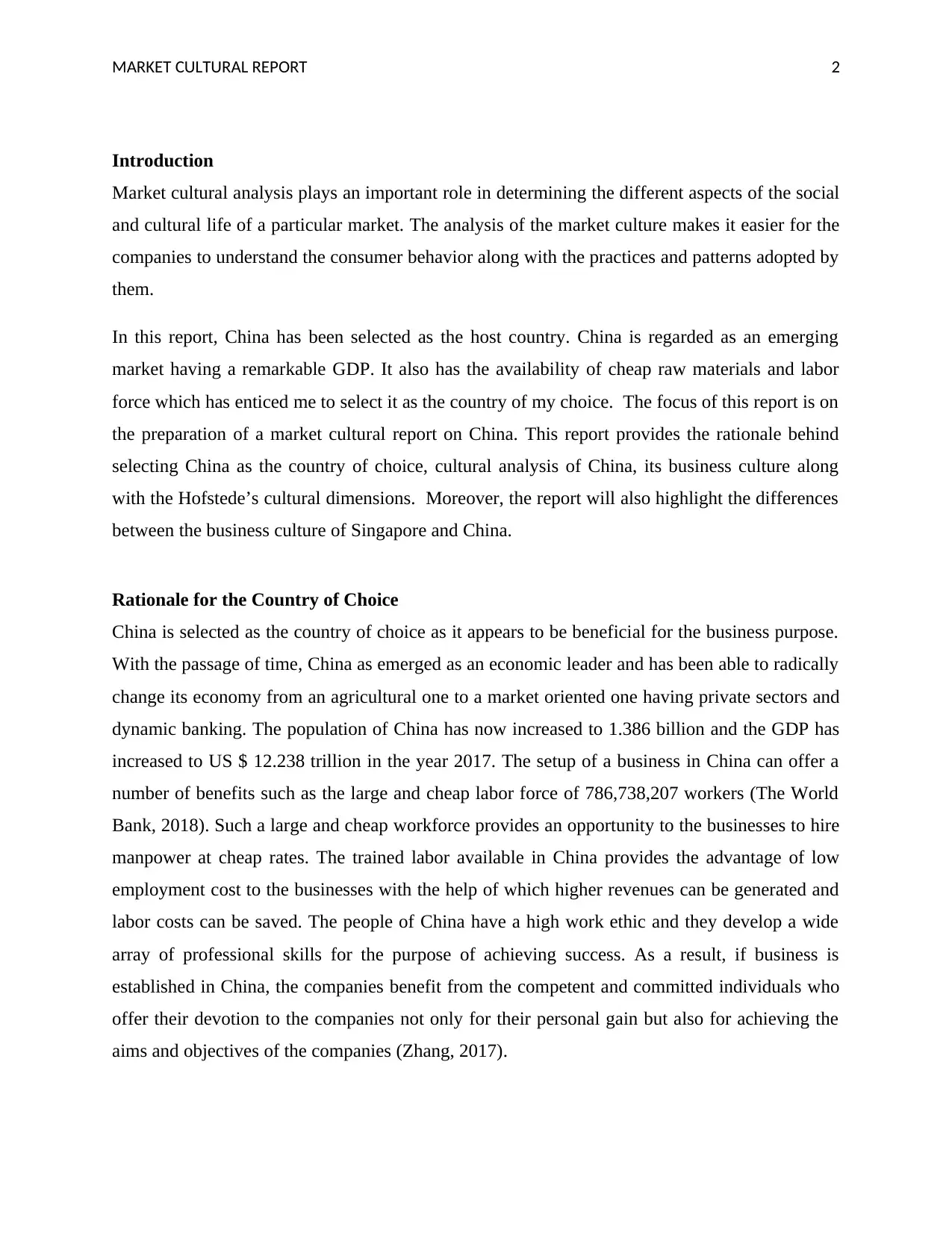
MARKET CULTURAL REPORT 2
Introduction
Market cultural analysis plays an important role in determining the different aspects of the social
and cultural life of a particular market. The analysis of the market culture makes it easier for the
companies to understand the consumer behavior along with the practices and patterns adopted by
them.
In this report, China has been selected as the host country. China is regarded as an emerging
market having a remarkable GDP. It also has the availability of cheap raw materials and labor
force which has enticed me to select it as the country of my choice. The focus of this report is on
the preparation of a market cultural report on China. This report provides the rationale behind
selecting China as the country of choice, cultural analysis of China, its business culture along
with the Hofstede’s cultural dimensions. Moreover, the report will also highlight the differences
between the business culture of Singapore and China.
Rationale for the Country of Choice
China is selected as the country of choice as it appears to be beneficial for the business purpose.
With the passage of time, China as emerged as an economic leader and has been able to radically
change its economy from an agricultural one to a market oriented one having private sectors and
dynamic banking. The population of China has now increased to 1.386 billion and the GDP has
increased to US $ 12.238 trillion in the year 2017. The setup of a business in China can offer a
number of benefits such as the large and cheap labor force of 786,738,207 workers (The World
Bank, 2018). Such a large and cheap workforce provides an opportunity to the businesses to hire
manpower at cheap rates. The trained labor available in China provides the advantage of low
employment cost to the businesses with the help of which higher revenues can be generated and
labor costs can be saved. The people of China have a high work ethic and they develop a wide
array of professional skills for the purpose of achieving success. As a result, if business is
established in China, the companies benefit from the competent and committed individuals who
offer their devotion to the companies not only for their personal gain but also for achieving the
aims and objectives of the companies (Zhang, 2017).
Introduction
Market cultural analysis plays an important role in determining the different aspects of the social
and cultural life of a particular market. The analysis of the market culture makes it easier for the
companies to understand the consumer behavior along with the practices and patterns adopted by
them.
In this report, China has been selected as the host country. China is regarded as an emerging
market having a remarkable GDP. It also has the availability of cheap raw materials and labor
force which has enticed me to select it as the country of my choice. The focus of this report is on
the preparation of a market cultural report on China. This report provides the rationale behind
selecting China as the country of choice, cultural analysis of China, its business culture along
with the Hofstede’s cultural dimensions. Moreover, the report will also highlight the differences
between the business culture of Singapore and China.
Rationale for the Country of Choice
China is selected as the country of choice as it appears to be beneficial for the business purpose.
With the passage of time, China as emerged as an economic leader and has been able to radically
change its economy from an agricultural one to a market oriented one having private sectors and
dynamic banking. The population of China has now increased to 1.386 billion and the GDP has
increased to US $ 12.238 trillion in the year 2017. The setup of a business in China can offer a
number of benefits such as the large and cheap labor force of 786,738,207 workers (The World
Bank, 2018). Such a large and cheap workforce provides an opportunity to the businesses to hire
manpower at cheap rates. The trained labor available in China provides the advantage of low
employment cost to the businesses with the help of which higher revenues can be generated and
labor costs can be saved. The people of China have a high work ethic and they develop a wide
array of professional skills for the purpose of achieving success. As a result, if business is
established in China, the companies benefit from the competent and committed individuals who
offer their devotion to the companies not only for their personal gain but also for achieving the
aims and objectives of the companies (Zhang, 2017).
⊘ This is a preview!⊘
Do you want full access?
Subscribe today to unlock all pages.

Trusted by 1+ million students worldwide
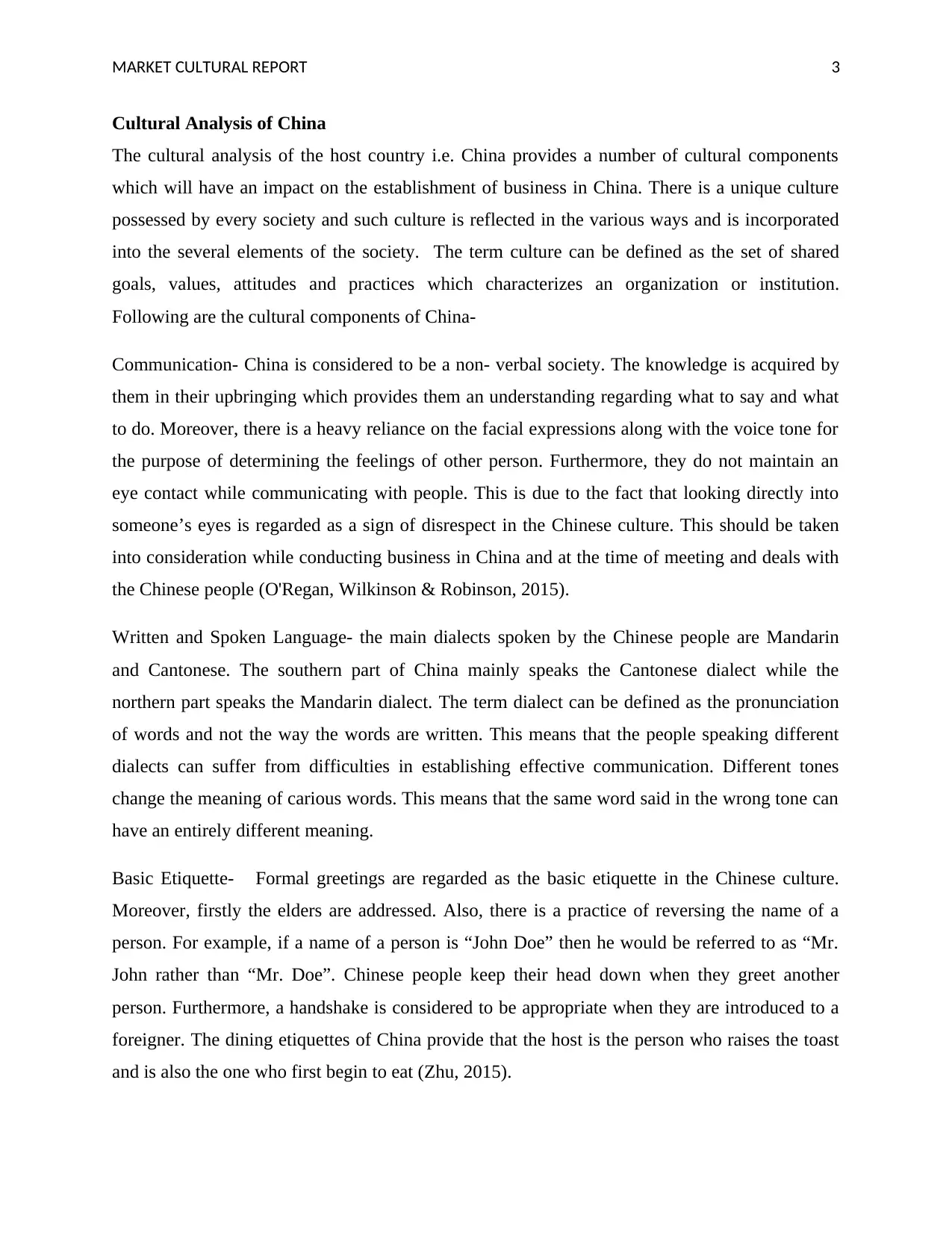
MARKET CULTURAL REPORT 3
Cultural Analysis of China
The cultural analysis of the host country i.e. China provides a number of cultural components
which will have an impact on the establishment of business in China. There is a unique culture
possessed by every society and such culture is reflected in the various ways and is incorporated
into the several elements of the society. The term culture can be defined as the set of shared
goals, values, attitudes and practices which characterizes an organization or institution.
Following are the cultural components of China-
Communication- China is considered to be a non- verbal society. The knowledge is acquired by
them in their upbringing which provides them an understanding regarding what to say and what
to do. Moreover, there is a heavy reliance on the facial expressions along with the voice tone for
the purpose of determining the feelings of other person. Furthermore, they do not maintain an
eye contact while communicating with people. This is due to the fact that looking directly into
someone’s eyes is regarded as a sign of disrespect in the Chinese culture. This should be taken
into consideration while conducting business in China and at the time of meeting and deals with
the Chinese people (O'Regan, Wilkinson & Robinson, 2015).
Written and Spoken Language- the main dialects spoken by the Chinese people are Mandarin
and Cantonese. The southern part of China mainly speaks the Cantonese dialect while the
northern part speaks the Mandarin dialect. The term dialect can be defined as the pronunciation
of words and not the way the words are written. This means that the people speaking different
dialects can suffer from difficulties in establishing effective communication. Different tones
change the meaning of carious words. This means that the same word said in the wrong tone can
have an entirely different meaning.
Basic Etiquette- Formal greetings are regarded as the basic etiquette in the Chinese culture.
Moreover, firstly the elders are addressed. Also, there is a practice of reversing the name of a
person. For example, if a name of a person is “John Doe” then he would be referred to as “Mr.
John rather than “Mr. Doe”. Chinese people keep their head down when they greet another
person. Furthermore, a handshake is considered to be appropriate when they are introduced to a
foreigner. The dining etiquettes of China provide that the host is the person who raises the toast
and is also the one who first begin to eat (Zhu, 2015).
Cultural Analysis of China
The cultural analysis of the host country i.e. China provides a number of cultural components
which will have an impact on the establishment of business in China. There is a unique culture
possessed by every society and such culture is reflected in the various ways and is incorporated
into the several elements of the society. The term culture can be defined as the set of shared
goals, values, attitudes and practices which characterizes an organization or institution.
Following are the cultural components of China-
Communication- China is considered to be a non- verbal society. The knowledge is acquired by
them in their upbringing which provides them an understanding regarding what to say and what
to do. Moreover, there is a heavy reliance on the facial expressions along with the voice tone for
the purpose of determining the feelings of other person. Furthermore, they do not maintain an
eye contact while communicating with people. This is due to the fact that looking directly into
someone’s eyes is regarded as a sign of disrespect in the Chinese culture. This should be taken
into consideration while conducting business in China and at the time of meeting and deals with
the Chinese people (O'Regan, Wilkinson & Robinson, 2015).
Written and Spoken Language- the main dialects spoken by the Chinese people are Mandarin
and Cantonese. The southern part of China mainly speaks the Cantonese dialect while the
northern part speaks the Mandarin dialect. The term dialect can be defined as the pronunciation
of words and not the way the words are written. This means that the people speaking different
dialects can suffer from difficulties in establishing effective communication. Different tones
change the meaning of carious words. This means that the same word said in the wrong tone can
have an entirely different meaning.
Basic Etiquette- Formal greetings are regarded as the basic etiquette in the Chinese culture.
Moreover, firstly the elders are addressed. Also, there is a practice of reversing the name of a
person. For example, if a name of a person is “John Doe” then he would be referred to as “Mr.
John rather than “Mr. Doe”. Chinese people keep their head down when they greet another
person. Furthermore, a handshake is considered to be appropriate when they are introduced to a
foreigner. The dining etiquettes of China provide that the host is the person who raises the toast
and is also the one who first begin to eat (Zhu, 2015).
Paraphrase This Document
Need a fresh take? Get an instant paraphrase of this document with our AI Paraphraser
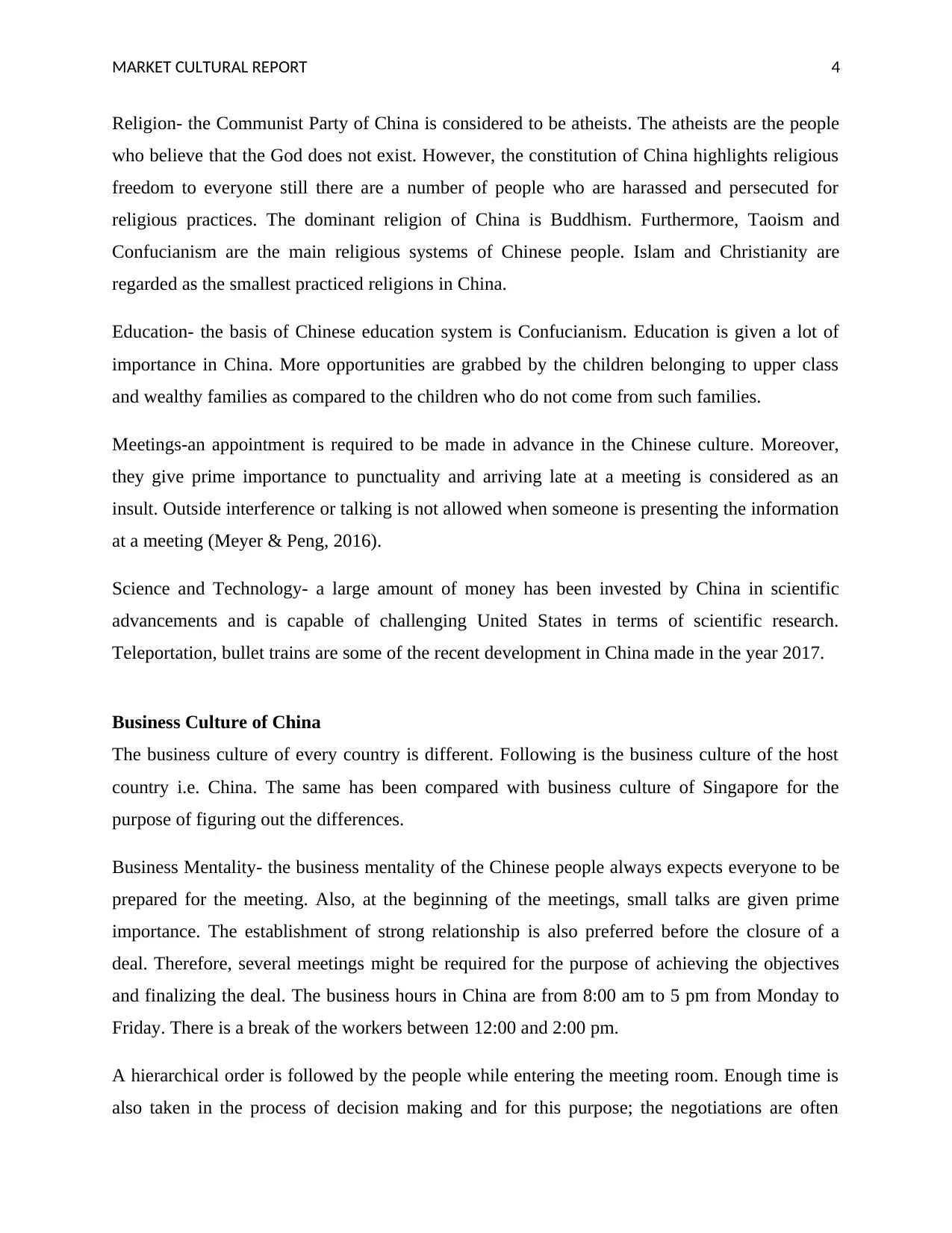
MARKET CULTURAL REPORT 4
Religion- the Communist Party of China is considered to be atheists. The atheists are the people
who believe that the God does not exist. However, the constitution of China highlights religious
freedom to everyone still there are a number of people who are harassed and persecuted for
religious practices. The dominant religion of China is Buddhism. Furthermore, Taoism and
Confucianism are the main religious systems of Chinese people. Islam and Christianity are
regarded as the smallest practiced religions in China.
Education- the basis of Chinese education system is Confucianism. Education is given a lot of
importance in China. More opportunities are grabbed by the children belonging to upper class
and wealthy families as compared to the children who do not come from such families.
Meetings-an appointment is required to be made in advance in the Chinese culture. Moreover,
they give prime importance to punctuality and arriving late at a meeting is considered as an
insult. Outside interference or talking is not allowed when someone is presenting the information
at a meeting (Meyer & Peng, 2016).
Science and Technology- a large amount of money has been invested by China in scientific
advancements and is capable of challenging United States in terms of scientific research.
Teleportation, bullet trains are some of the recent development in China made in the year 2017.
Business Culture of China
The business culture of every country is different. Following is the business culture of the host
country i.e. China. The same has been compared with business culture of Singapore for the
purpose of figuring out the differences.
Business Mentality- the business mentality of the Chinese people always expects everyone to be
prepared for the meeting. Also, at the beginning of the meetings, small talks are given prime
importance. The establishment of strong relationship is also preferred before the closure of a
deal. Therefore, several meetings might be required for the purpose of achieving the objectives
and finalizing the deal. The business hours in China are from 8:00 am to 5 pm from Monday to
Friday. There is a break of the workers between 12:00 and 2:00 pm.
A hierarchical order is followed by the people while entering the meeting room. Enough time is
also taken in the process of decision making and for this purpose; the negotiations are often
Religion- the Communist Party of China is considered to be atheists. The atheists are the people
who believe that the God does not exist. However, the constitution of China highlights religious
freedom to everyone still there are a number of people who are harassed and persecuted for
religious practices. The dominant religion of China is Buddhism. Furthermore, Taoism and
Confucianism are the main religious systems of Chinese people. Islam and Christianity are
regarded as the smallest practiced religions in China.
Education- the basis of Chinese education system is Confucianism. Education is given a lot of
importance in China. More opportunities are grabbed by the children belonging to upper class
and wealthy families as compared to the children who do not come from such families.
Meetings-an appointment is required to be made in advance in the Chinese culture. Moreover,
they give prime importance to punctuality and arriving late at a meeting is considered as an
insult. Outside interference or talking is not allowed when someone is presenting the information
at a meeting (Meyer & Peng, 2016).
Science and Technology- a large amount of money has been invested by China in scientific
advancements and is capable of challenging United States in terms of scientific research.
Teleportation, bullet trains are some of the recent development in China made in the year 2017.
Business Culture of China
The business culture of every country is different. Following is the business culture of the host
country i.e. China. The same has been compared with business culture of Singapore for the
purpose of figuring out the differences.
Business Mentality- the business mentality of the Chinese people always expects everyone to be
prepared for the meeting. Also, at the beginning of the meetings, small talks are given prime
importance. The establishment of strong relationship is also preferred before the closure of a
deal. Therefore, several meetings might be required for the purpose of achieving the objectives
and finalizing the deal. The business hours in China are from 8:00 am to 5 pm from Monday to
Friday. There is a break of the workers between 12:00 and 2:00 pm.
A hierarchical order is followed by the people while entering the meeting room. Enough time is
also taken in the process of decision making and for this purpose; the negotiations are often
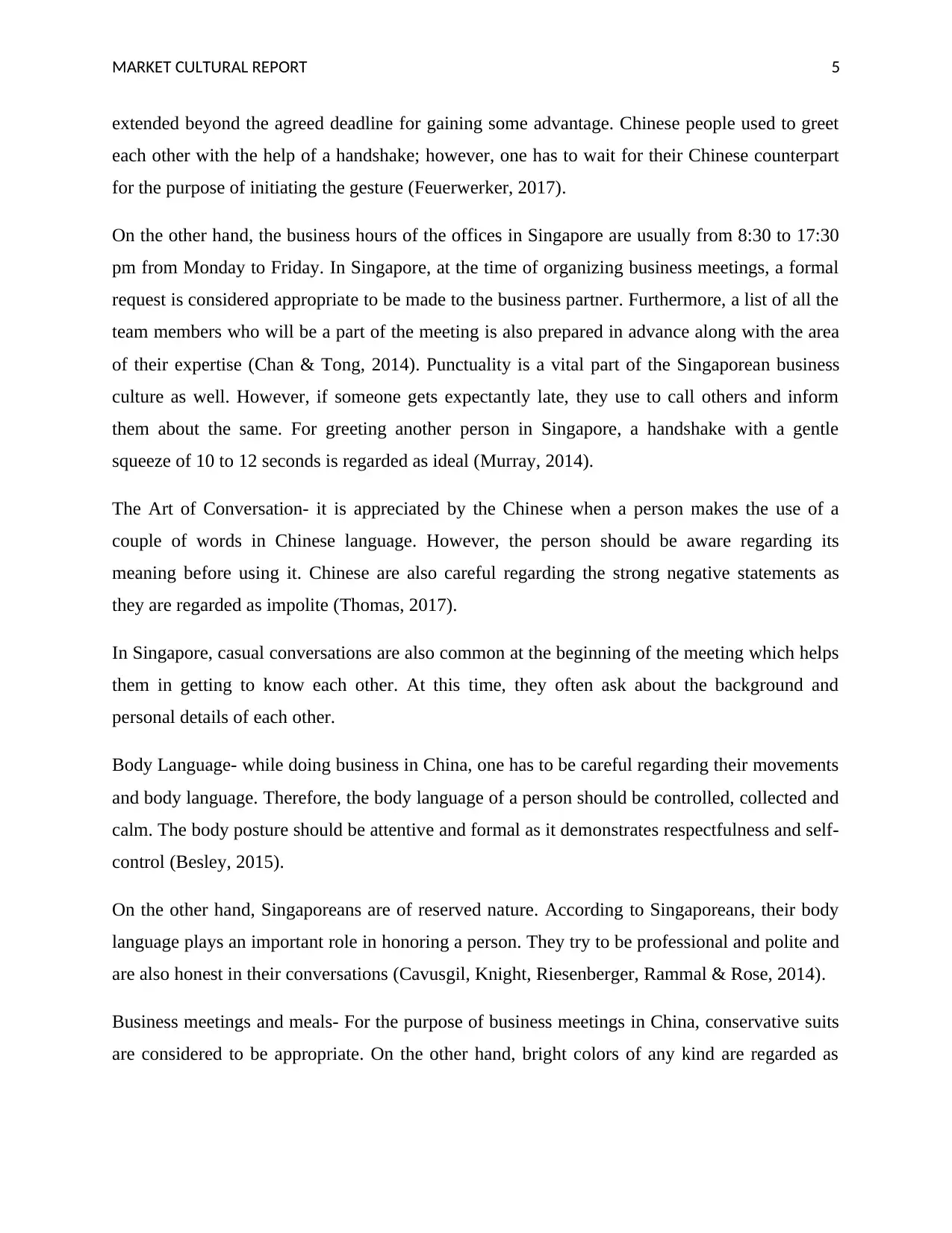
MARKET CULTURAL REPORT 5
extended beyond the agreed deadline for gaining some advantage. Chinese people used to greet
each other with the help of a handshake; however, one has to wait for their Chinese counterpart
for the purpose of initiating the gesture (Feuerwerker, 2017).
On the other hand, the business hours of the offices in Singapore are usually from 8:30 to 17:30
pm from Monday to Friday. In Singapore, at the time of organizing business meetings, a formal
request is considered appropriate to be made to the business partner. Furthermore, a list of all the
team members who will be a part of the meeting is also prepared in advance along with the area
of their expertise (Chan & Tong, 2014). Punctuality is a vital part of the Singaporean business
culture as well. However, if someone gets expectantly late, they use to call others and inform
them about the same. For greeting another person in Singapore, a handshake with a gentle
squeeze of 10 to 12 seconds is regarded as ideal (Murray, 2014).
The Art of Conversation- it is appreciated by the Chinese when a person makes the use of a
couple of words in Chinese language. However, the person should be aware regarding its
meaning before using it. Chinese are also careful regarding the strong negative statements as
they are regarded as impolite (Thomas, 2017).
In Singapore, casual conversations are also common at the beginning of the meeting which helps
them in getting to know each other. At this time, they often ask about the background and
personal details of each other.
Body Language- while doing business in China, one has to be careful regarding their movements
and body language. Therefore, the body language of a person should be controlled, collected and
calm. The body posture should be attentive and formal as it demonstrates respectfulness and self-
control (Besley, 2015).
On the other hand, Singaporeans are of reserved nature. According to Singaporeans, their body
language plays an important role in honoring a person. They try to be professional and polite and
are also honest in their conversations (Cavusgil, Knight, Riesenberger, Rammal & Rose, 2014).
Business meetings and meals- For the purpose of business meetings in China, conservative suits
are considered to be appropriate. On the other hand, bright colors of any kind are regarded as
extended beyond the agreed deadline for gaining some advantage. Chinese people used to greet
each other with the help of a handshake; however, one has to wait for their Chinese counterpart
for the purpose of initiating the gesture (Feuerwerker, 2017).
On the other hand, the business hours of the offices in Singapore are usually from 8:30 to 17:30
pm from Monday to Friday. In Singapore, at the time of organizing business meetings, a formal
request is considered appropriate to be made to the business partner. Furthermore, a list of all the
team members who will be a part of the meeting is also prepared in advance along with the area
of their expertise (Chan & Tong, 2014). Punctuality is a vital part of the Singaporean business
culture as well. However, if someone gets expectantly late, they use to call others and inform
them about the same. For greeting another person in Singapore, a handshake with a gentle
squeeze of 10 to 12 seconds is regarded as ideal (Murray, 2014).
The Art of Conversation- it is appreciated by the Chinese when a person makes the use of a
couple of words in Chinese language. However, the person should be aware regarding its
meaning before using it. Chinese are also careful regarding the strong negative statements as
they are regarded as impolite (Thomas, 2017).
In Singapore, casual conversations are also common at the beginning of the meeting which helps
them in getting to know each other. At this time, they often ask about the background and
personal details of each other.
Body Language- while doing business in China, one has to be careful regarding their movements
and body language. Therefore, the body language of a person should be controlled, collected and
calm. The body posture should be attentive and formal as it demonstrates respectfulness and self-
control (Besley, 2015).
On the other hand, Singaporeans are of reserved nature. According to Singaporeans, their body
language plays an important role in honoring a person. They try to be professional and polite and
are also honest in their conversations (Cavusgil, Knight, Riesenberger, Rammal & Rose, 2014).
Business meetings and meals- For the purpose of business meetings in China, conservative suits
are considered to be appropriate. On the other hand, bright colors of any kind are regarded as
⊘ This is a preview!⊘
Do you want full access?
Subscribe today to unlock all pages.

Trusted by 1+ million students worldwide
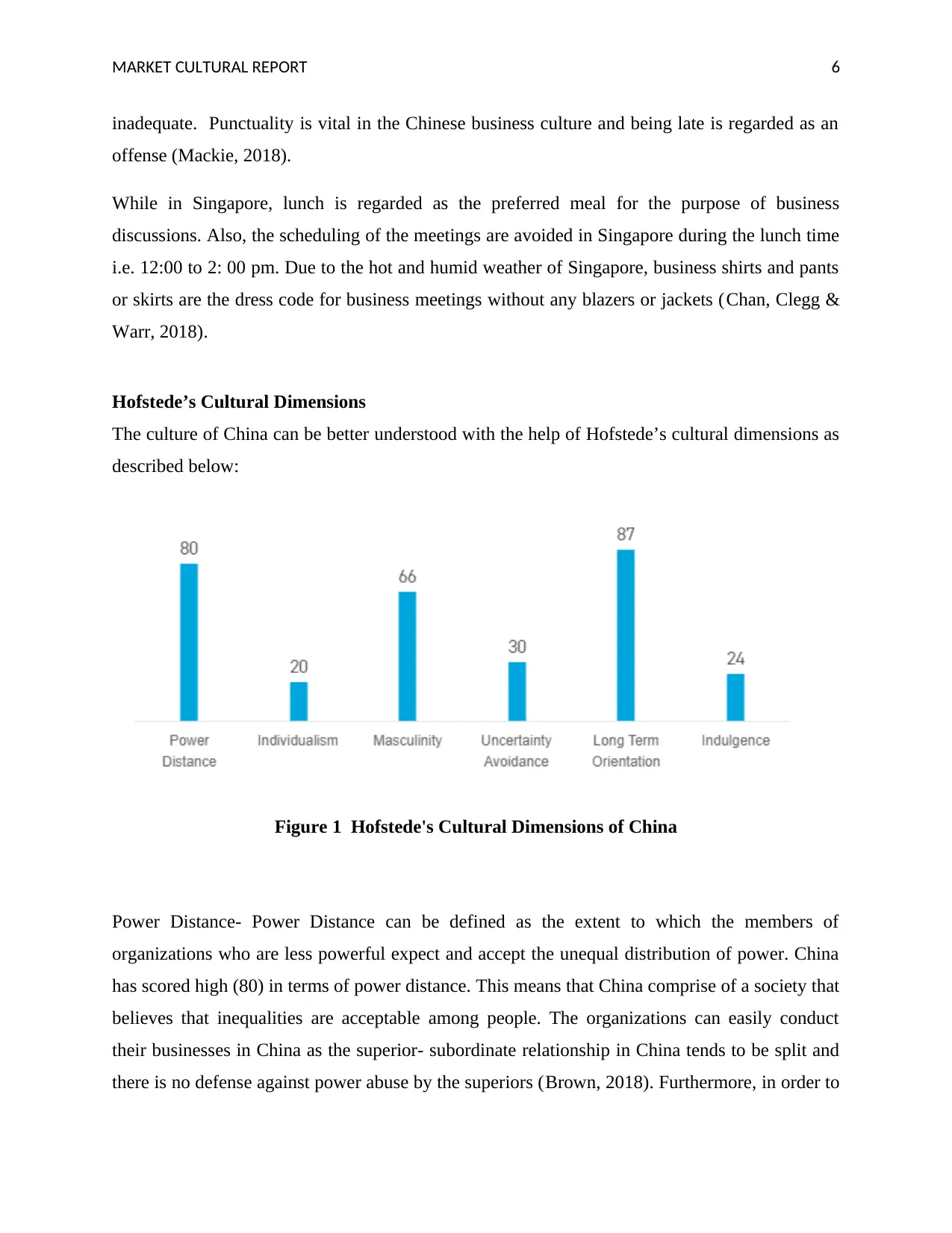
MARKET CULTURAL REPORT 6
inadequate. Punctuality is vital in the Chinese business culture and being late is regarded as an
offense (Mackie, 2018).
While in Singapore, lunch is regarded as the preferred meal for the purpose of business
discussions. Also, the scheduling of the meetings are avoided in Singapore during the lunch time
i.e. 12:00 to 2: 00 pm. Due to the hot and humid weather of Singapore, business shirts and pants
or skirts are the dress code for business meetings without any blazers or jackets (Chan, Clegg &
Warr, 2018).
Hofstede’s Cultural Dimensions
The culture of China can be better understood with the help of Hofstede’s cultural dimensions as
described below:
Figure 1 Hofstede's Cultural Dimensions of China
Power Distance- Power Distance can be defined as the extent to which the members of
organizations who are less powerful expect and accept the unequal distribution of power. China
has scored high (80) in terms of power distance. This means that China comprise of a society that
believes that inequalities are acceptable among people. The organizations can easily conduct
their businesses in China as the superior- subordinate relationship in China tends to be split and
there is no defense against power abuse by the superiors (Brown, 2018). Furthermore, in order to
inadequate. Punctuality is vital in the Chinese business culture and being late is regarded as an
offense (Mackie, 2018).
While in Singapore, lunch is regarded as the preferred meal for the purpose of business
discussions. Also, the scheduling of the meetings are avoided in Singapore during the lunch time
i.e. 12:00 to 2: 00 pm. Due to the hot and humid weather of Singapore, business shirts and pants
or skirts are the dress code for business meetings without any blazers or jackets (Chan, Clegg &
Warr, 2018).
Hofstede’s Cultural Dimensions
The culture of China can be better understood with the help of Hofstede’s cultural dimensions as
described below:
Figure 1 Hofstede's Cultural Dimensions of China
Power Distance- Power Distance can be defined as the extent to which the members of
organizations who are less powerful expect and accept the unequal distribution of power. China
has scored high (80) in terms of power distance. This means that China comprise of a society that
believes that inequalities are acceptable among people. The organizations can easily conduct
their businesses in China as the superior- subordinate relationship in China tends to be split and
there is no defense against power abuse by the superiors (Brown, 2018). Furthermore, in order to
Paraphrase This Document
Need a fresh take? Get an instant paraphrase of this document with our AI Paraphraser
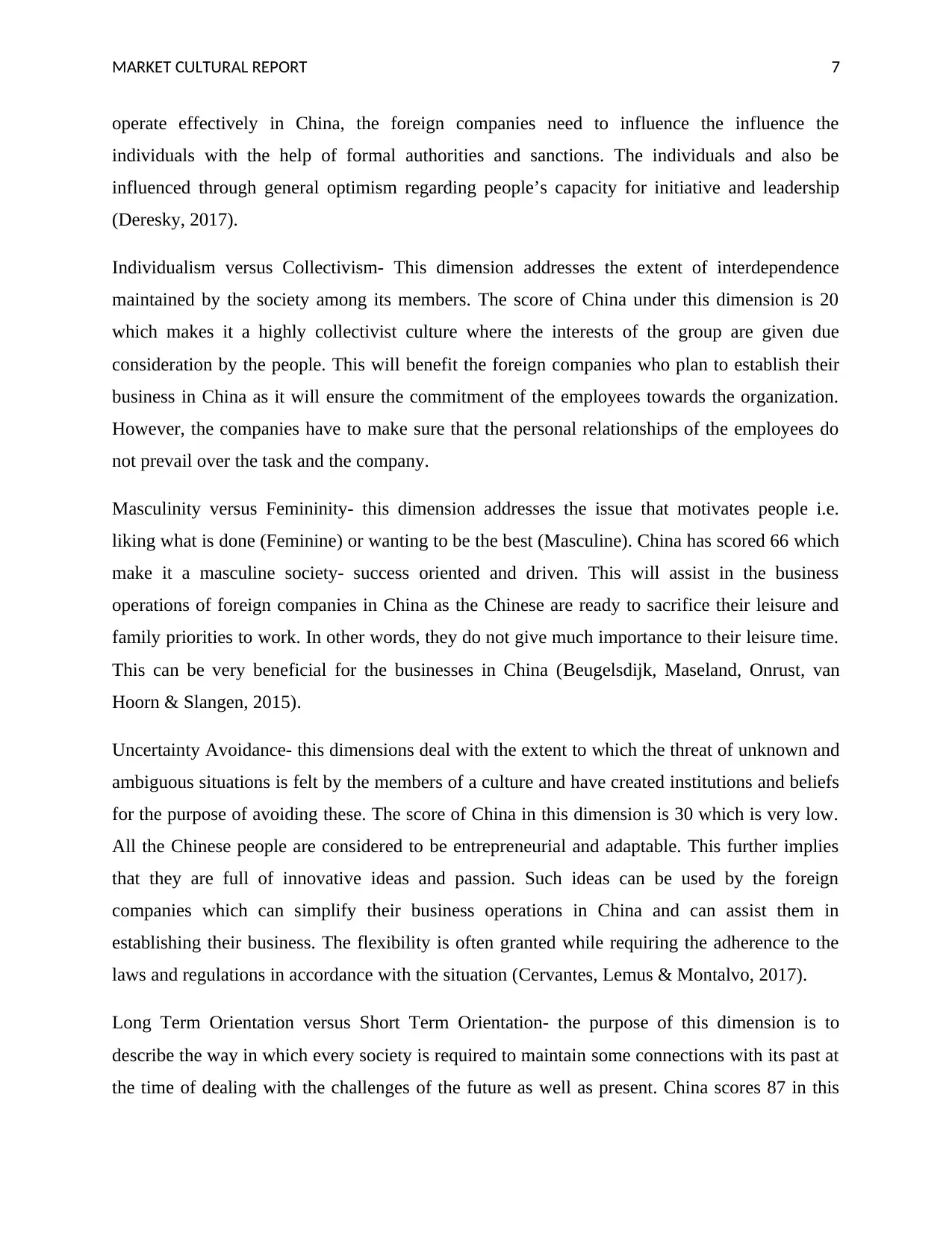
MARKET CULTURAL REPORT 7
operate effectively in China, the foreign companies need to influence the influence the
individuals with the help of formal authorities and sanctions. The individuals and also be
influenced through general optimism regarding people’s capacity for initiative and leadership
(Deresky, 2017).
Individualism versus Collectivism- This dimension addresses the extent of interdependence
maintained by the society among its members. The score of China under this dimension is 20
which makes it a highly collectivist culture where the interests of the group are given due
consideration by the people. This will benefit the foreign companies who plan to establish their
business in China as it will ensure the commitment of the employees towards the organization.
However, the companies have to make sure that the personal relationships of the employees do
not prevail over the task and the company.
Masculinity versus Femininity- this dimension addresses the issue that motivates people i.e.
liking what is done (Feminine) or wanting to be the best (Masculine). China has scored 66 which
make it a masculine society- success oriented and driven. This will assist in the business
operations of foreign companies in China as the Chinese are ready to sacrifice their leisure and
family priorities to work. In other words, they do not give much importance to their leisure time.
This can be very beneficial for the businesses in China (Beugelsdijk, Maseland, Onrust, van
Hoorn & Slangen, 2015).
Uncertainty Avoidance- this dimensions deal with the extent to which the threat of unknown and
ambiguous situations is felt by the members of a culture and have created institutions and beliefs
for the purpose of avoiding these. The score of China in this dimension is 30 which is very low.
All the Chinese people are considered to be entrepreneurial and adaptable. This further implies
that they are full of innovative ideas and passion. Such ideas can be used by the foreign
companies which can simplify their business operations in China and can assist them in
establishing their business. The flexibility is often granted while requiring the adherence to the
laws and regulations in accordance with the situation (Cervantes, Lemus & Montalvo, 2017).
Long Term Orientation versus Short Term Orientation- the purpose of this dimension is to
describe the way in which every society is required to maintain some connections with its past at
the time of dealing with the challenges of the future as well as present. China scores 87 in this
operate effectively in China, the foreign companies need to influence the influence the
individuals with the help of formal authorities and sanctions. The individuals and also be
influenced through general optimism regarding people’s capacity for initiative and leadership
(Deresky, 2017).
Individualism versus Collectivism- This dimension addresses the extent of interdependence
maintained by the society among its members. The score of China under this dimension is 20
which makes it a highly collectivist culture where the interests of the group are given due
consideration by the people. This will benefit the foreign companies who plan to establish their
business in China as it will ensure the commitment of the employees towards the organization.
However, the companies have to make sure that the personal relationships of the employees do
not prevail over the task and the company.
Masculinity versus Femininity- this dimension addresses the issue that motivates people i.e.
liking what is done (Feminine) or wanting to be the best (Masculine). China has scored 66 which
make it a masculine society- success oriented and driven. This will assist in the business
operations of foreign companies in China as the Chinese are ready to sacrifice their leisure and
family priorities to work. In other words, they do not give much importance to their leisure time.
This can be very beneficial for the businesses in China (Beugelsdijk, Maseland, Onrust, van
Hoorn & Slangen, 2015).
Uncertainty Avoidance- this dimensions deal with the extent to which the threat of unknown and
ambiguous situations is felt by the members of a culture and have created institutions and beliefs
for the purpose of avoiding these. The score of China in this dimension is 30 which is very low.
All the Chinese people are considered to be entrepreneurial and adaptable. This further implies
that they are full of innovative ideas and passion. Such ideas can be used by the foreign
companies which can simplify their business operations in China and can assist them in
establishing their business. The flexibility is often granted while requiring the adherence to the
laws and regulations in accordance with the situation (Cervantes, Lemus & Montalvo, 2017).
Long Term Orientation versus Short Term Orientation- the purpose of this dimension is to
describe the way in which every society is required to maintain some connections with its past at
the time of dealing with the challenges of the future as well as present. China scores 87 in this
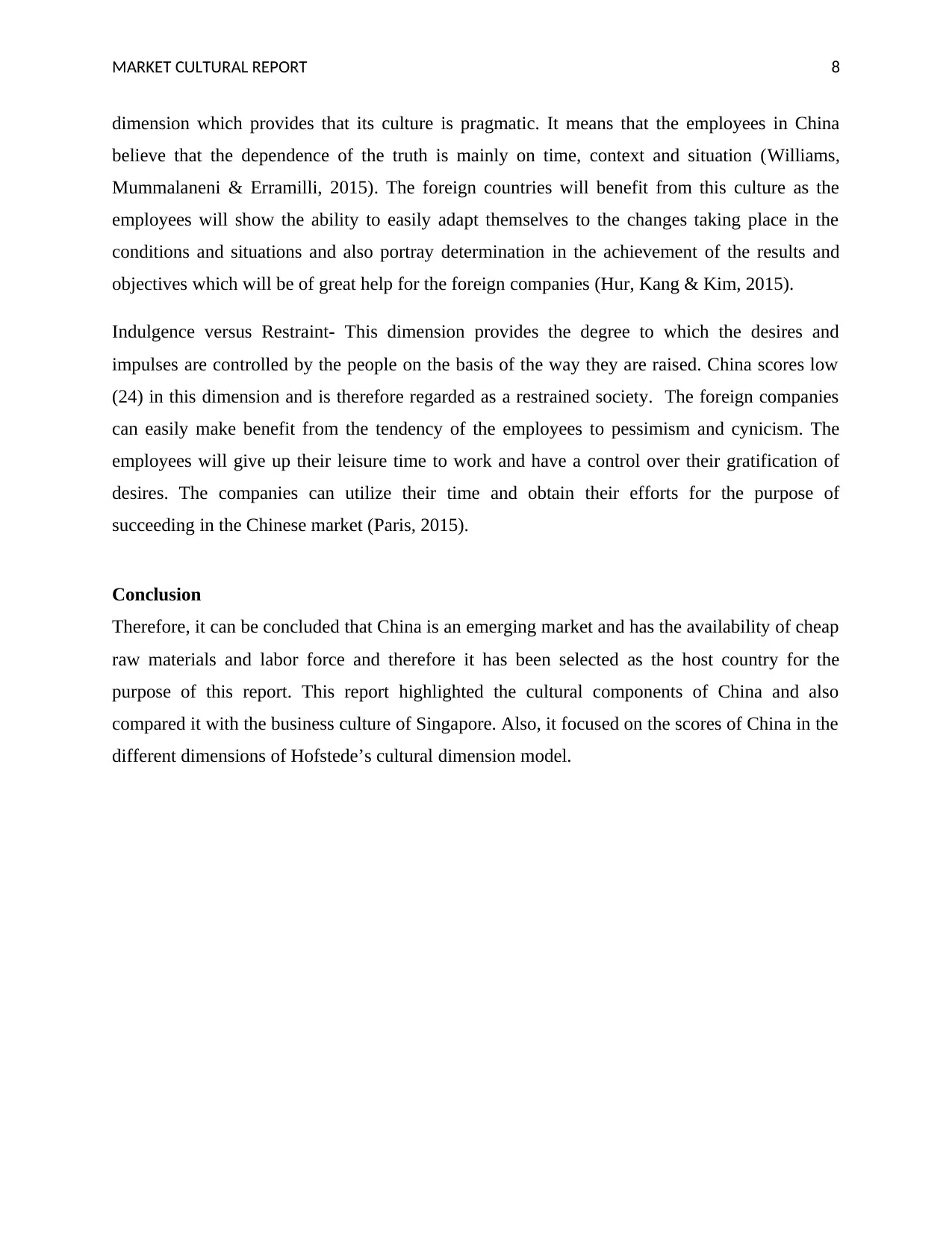
MARKET CULTURAL REPORT 8
dimension which provides that its culture is pragmatic. It means that the employees in China
believe that the dependence of the truth is mainly on time, context and situation (Williams,
Mummalaneni & Erramilli, 2015). The foreign countries will benefit from this culture as the
employees will show the ability to easily adapt themselves to the changes taking place in the
conditions and situations and also portray determination in the achievement of the results and
objectives which will be of great help for the foreign companies (Hur, Kang & Kim, 2015).
Indulgence versus Restraint- This dimension provides the degree to which the desires and
impulses are controlled by the people on the basis of the way they are raised. China scores low
(24) in this dimension and is therefore regarded as a restrained society. The foreign companies
can easily make benefit from the tendency of the employees to pessimism and cynicism. The
employees will give up their leisure time to work and have a control over their gratification of
desires. The companies can utilize their time and obtain their efforts for the purpose of
succeeding in the Chinese market (Paris, 2015).
Conclusion
Therefore, it can be concluded that China is an emerging market and has the availability of cheap
raw materials and labor force and therefore it has been selected as the host country for the
purpose of this report. This report highlighted the cultural components of China and also
compared it with the business culture of Singapore. Also, it focused on the scores of China in the
different dimensions of Hofstede’s cultural dimension model.
dimension which provides that its culture is pragmatic. It means that the employees in China
believe that the dependence of the truth is mainly on time, context and situation (Williams,
Mummalaneni & Erramilli, 2015). The foreign countries will benefit from this culture as the
employees will show the ability to easily adapt themselves to the changes taking place in the
conditions and situations and also portray determination in the achievement of the results and
objectives which will be of great help for the foreign companies (Hur, Kang & Kim, 2015).
Indulgence versus Restraint- This dimension provides the degree to which the desires and
impulses are controlled by the people on the basis of the way they are raised. China scores low
(24) in this dimension and is therefore regarded as a restrained society. The foreign companies
can easily make benefit from the tendency of the employees to pessimism and cynicism. The
employees will give up their leisure time to work and have a control over their gratification of
desires. The companies can utilize their time and obtain their efforts for the purpose of
succeeding in the Chinese market (Paris, 2015).
Conclusion
Therefore, it can be concluded that China is an emerging market and has the availability of cheap
raw materials and labor force and therefore it has been selected as the host country for the
purpose of this report. This report highlighted the cultural components of China and also
compared it with the business culture of Singapore. Also, it focused on the scores of China in the
different dimensions of Hofstede’s cultural dimension model.
⊘ This is a preview!⊘
Do you want full access?
Subscribe today to unlock all pages.

Trusted by 1+ million students worldwide
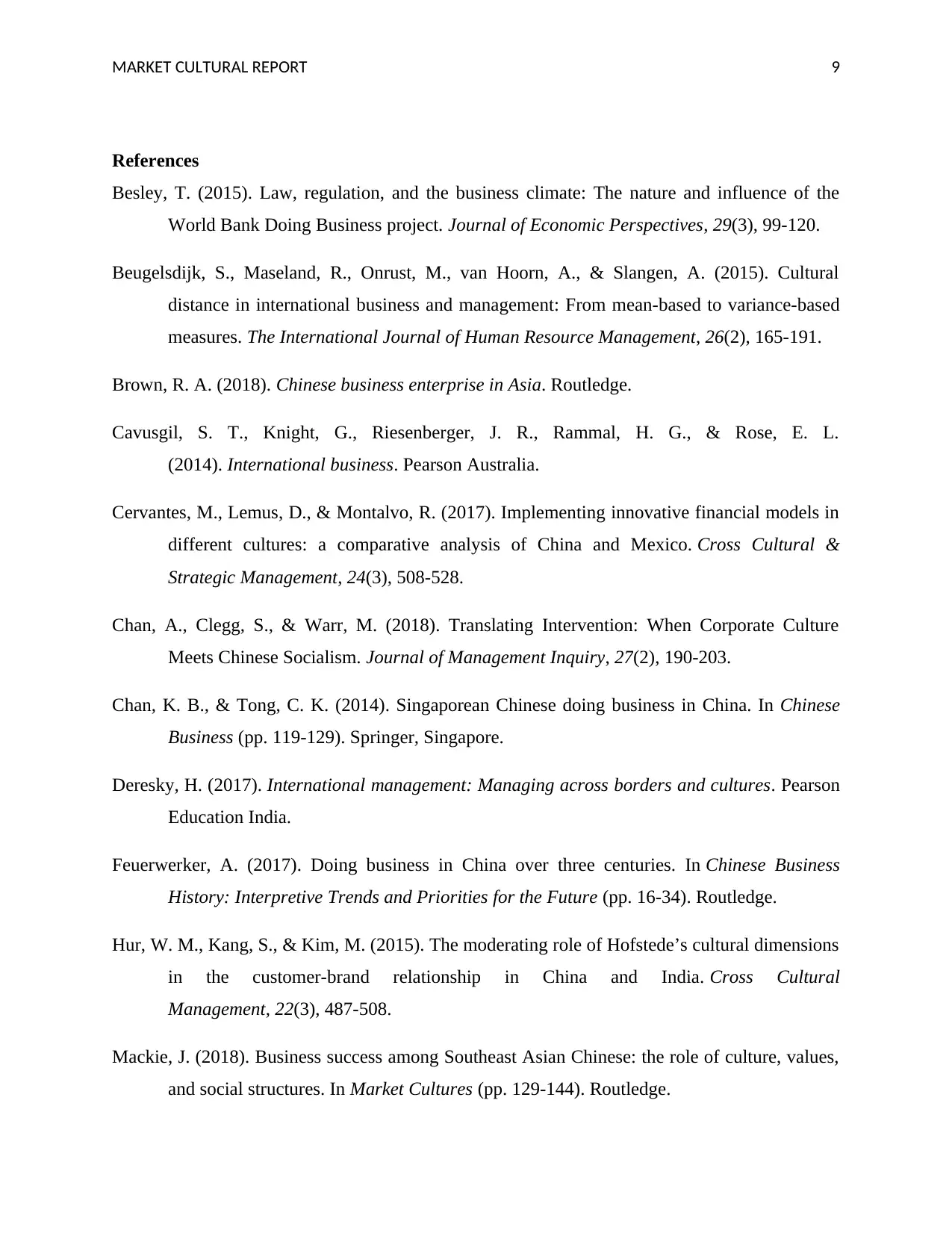
MARKET CULTURAL REPORT 9
References
Besley, T. (2015). Law, regulation, and the business climate: The nature and influence of the
World Bank Doing Business project. Journal of Economic Perspectives, 29(3), 99-120.
Beugelsdijk, S., Maseland, R., Onrust, M., van Hoorn, A., & Slangen, A. (2015). Cultural
distance in international business and management: From mean-based to variance-based
measures. The International Journal of Human Resource Management, 26(2), 165-191.
Brown, R. A. (2018). Chinese business enterprise in Asia. Routledge.
Cavusgil, S. T., Knight, G., Riesenberger, J. R., Rammal, H. G., & Rose, E. L.
(2014). International business. Pearson Australia.
Cervantes, M., Lemus, D., & Montalvo, R. (2017). Implementing innovative financial models in
different cultures: a comparative analysis of China and Mexico. Cross Cultural &
Strategic Management, 24(3), 508-528.
Chan, A., Clegg, S., & Warr, M. (2018). Translating Intervention: When Corporate Culture
Meets Chinese Socialism. Journal of Management Inquiry, 27(2), 190-203.
Chan, K. B., & Tong, C. K. (2014). Singaporean Chinese doing business in China. In Chinese
Business (pp. 119-129). Springer, Singapore.
Deresky, H. (2017). International management: Managing across borders and cultures. Pearson
Education India.
Feuerwerker, A. (2017). Doing business in China over three centuries. In Chinese Business
History: Interpretive Trends and Priorities for the Future (pp. 16-34). Routledge.
Hur, W. M., Kang, S., & Kim, M. (2015). The moderating role of Hofstede’s cultural dimensions
in the customer-brand relationship in China and India. Cross Cultural
Management, 22(3), 487-508.
Mackie, J. (2018). Business success among Southeast Asian Chinese: the role of culture, values,
and social structures. In Market Cultures (pp. 129-144). Routledge.
References
Besley, T. (2015). Law, regulation, and the business climate: The nature and influence of the
World Bank Doing Business project. Journal of Economic Perspectives, 29(3), 99-120.
Beugelsdijk, S., Maseland, R., Onrust, M., van Hoorn, A., & Slangen, A. (2015). Cultural
distance in international business and management: From mean-based to variance-based
measures. The International Journal of Human Resource Management, 26(2), 165-191.
Brown, R. A. (2018). Chinese business enterprise in Asia. Routledge.
Cavusgil, S. T., Knight, G., Riesenberger, J. R., Rammal, H. G., & Rose, E. L.
(2014). International business. Pearson Australia.
Cervantes, M., Lemus, D., & Montalvo, R. (2017). Implementing innovative financial models in
different cultures: a comparative analysis of China and Mexico. Cross Cultural &
Strategic Management, 24(3), 508-528.
Chan, A., Clegg, S., & Warr, M. (2018). Translating Intervention: When Corporate Culture
Meets Chinese Socialism. Journal of Management Inquiry, 27(2), 190-203.
Chan, K. B., & Tong, C. K. (2014). Singaporean Chinese doing business in China. In Chinese
Business (pp. 119-129). Springer, Singapore.
Deresky, H. (2017). International management: Managing across borders and cultures. Pearson
Education India.
Feuerwerker, A. (2017). Doing business in China over three centuries. In Chinese Business
History: Interpretive Trends and Priorities for the Future (pp. 16-34). Routledge.
Hur, W. M., Kang, S., & Kim, M. (2015). The moderating role of Hofstede’s cultural dimensions
in the customer-brand relationship in China and India. Cross Cultural
Management, 22(3), 487-508.
Mackie, J. (2018). Business success among Southeast Asian Chinese: the role of culture, values,
and social structures. In Market Cultures (pp. 129-144). Routledge.
Paraphrase This Document
Need a fresh take? Get an instant paraphrase of this document with our AI Paraphraser
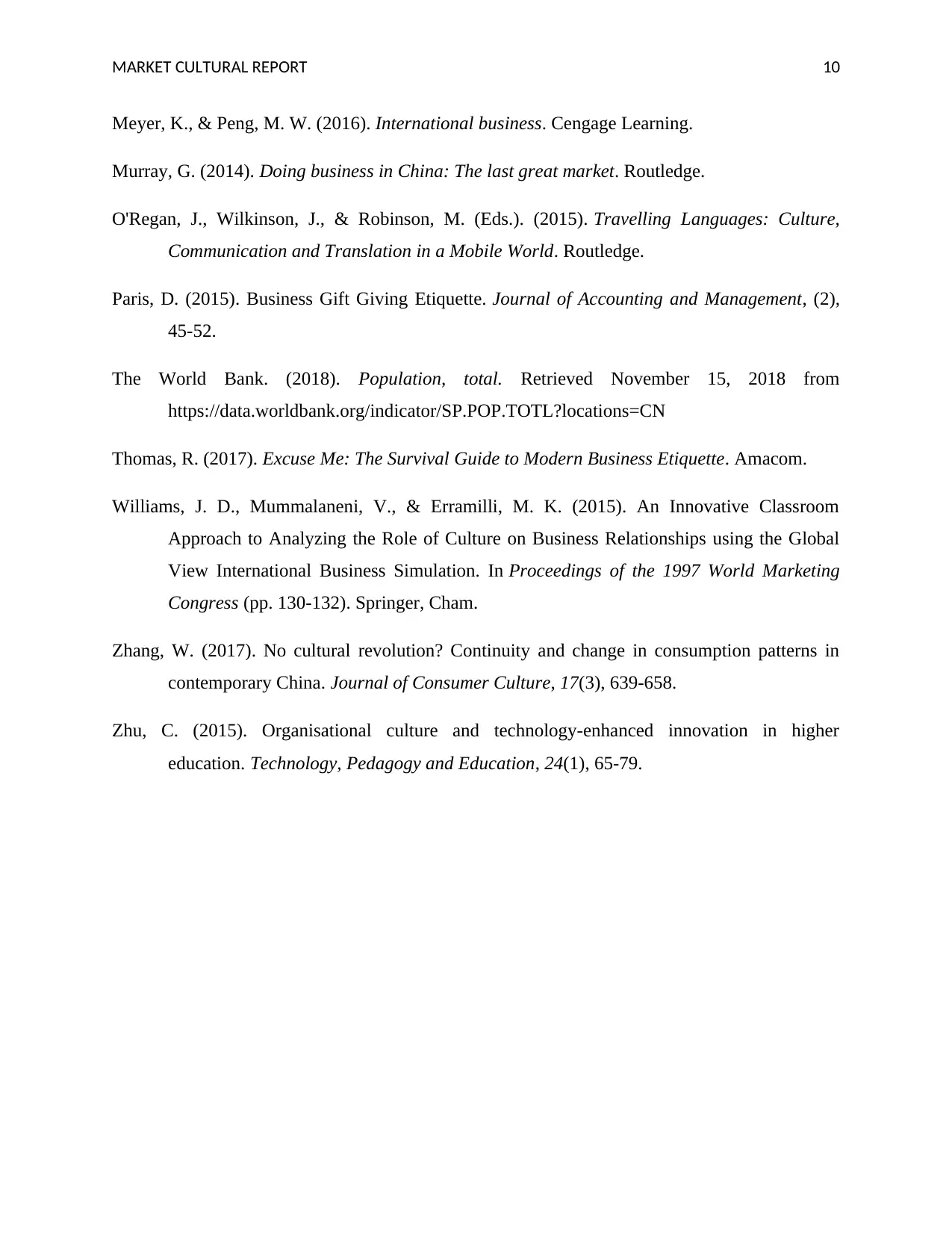
MARKET CULTURAL REPORT 10
Meyer, K., & Peng, M. W. (2016). International business. Cengage Learning.
Murray, G. (2014). Doing business in China: The last great market. Routledge.
O'Regan, J., Wilkinson, J., & Robinson, M. (Eds.). (2015). Travelling Languages: Culture,
Communication and Translation in a Mobile World. Routledge.
Paris, D. (2015). Business Gift Giving Etiquette. Journal of Accounting and Management, (2),
45-52.
The World Bank. (2018). Population, total. Retrieved November 15, 2018 from
https://data.worldbank.org/indicator/SP.POP.TOTL?locations=CN
Thomas, R. (2017). Excuse Me: The Survival Guide to Modern Business Etiquette. Amacom.
Williams, J. D., Mummalaneni, V., & Erramilli, M. K. (2015). An Innovative Classroom
Approach to Analyzing the Role of Culture on Business Relationships using the Global
View International Business Simulation. In Proceedings of the 1997 World Marketing
Congress (pp. 130-132). Springer, Cham.
Zhang, W. (2017). No cultural revolution? Continuity and change in consumption patterns in
contemporary China. Journal of Consumer Culture, 17(3), 639-658.
Zhu, C. (2015). Organisational culture and technology-enhanced innovation in higher
education. Technology, Pedagogy and Education, 24(1), 65-79.
Meyer, K., & Peng, M. W. (2016). International business. Cengage Learning.
Murray, G. (2014). Doing business in China: The last great market. Routledge.
O'Regan, J., Wilkinson, J., & Robinson, M. (Eds.). (2015). Travelling Languages: Culture,
Communication and Translation in a Mobile World. Routledge.
Paris, D. (2015). Business Gift Giving Etiquette. Journal of Accounting and Management, (2),
45-52.
The World Bank. (2018). Population, total. Retrieved November 15, 2018 from
https://data.worldbank.org/indicator/SP.POP.TOTL?locations=CN
Thomas, R. (2017). Excuse Me: The Survival Guide to Modern Business Etiquette. Amacom.
Williams, J. D., Mummalaneni, V., & Erramilli, M. K. (2015). An Innovative Classroom
Approach to Analyzing the Role of Culture on Business Relationships using the Global
View International Business Simulation. In Proceedings of the 1997 World Marketing
Congress (pp. 130-132). Springer, Cham.
Zhang, W. (2017). No cultural revolution? Continuity and change in consumption patterns in
contemporary China. Journal of Consumer Culture, 17(3), 639-658.
Zhu, C. (2015). Organisational culture and technology-enhanced innovation in higher
education. Technology, Pedagogy and Education, 24(1), 65-79.
1 out of 11
Related Documents
Your All-in-One AI-Powered Toolkit for Academic Success.
+13062052269
info@desklib.com
Available 24*7 on WhatsApp / Email
![[object Object]](/_next/static/media/star-bottom.7253800d.svg)
Unlock your academic potential
Copyright © 2020–2025 A2Z Services. All Rights Reserved. Developed and managed by ZUCOL.





